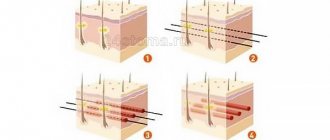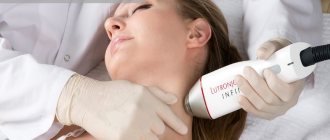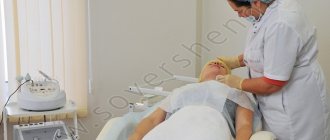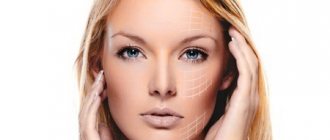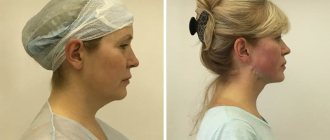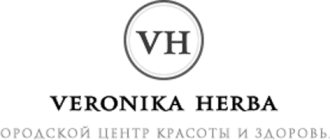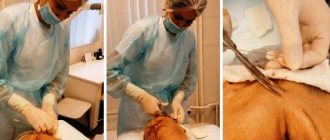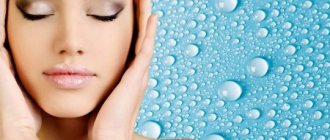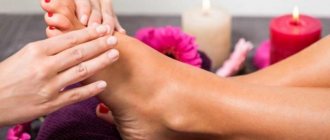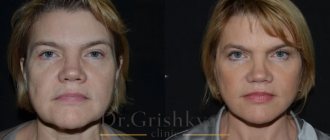- Description
- Photo
- Sign up for the procedure
Thread lifting Resorblift of the forehead and/or eyebrows is a lift using threads by moving and fixing the soft tissues of the upper third of the face.
Eyebrow and forehead lifting is most often indicated for patients over 40 years of age to reduce the first signs of aging in this area. In this age category, lifting of the upper third of the face is most in demand. However, if the problem of drooping eyebrows and/or ptosis of tissues, deep furrows in the forehead occurs in younger patients, this procedure can also be recommended for them.
The advantage of Resorblift thread lifting is its scientifically proven effectiveness, the ability to move and fix the soft tissues of the upper third of the face, the absence of rehabilitation and recovery periods, the absence of general anesthesia, and long-lasting results for up to 5 years.
The essence of the procedure
With age, many people experience drooping of the forehead and eyebrows. This is due to overstretching of the skin and hypertonicity of the frontal muscle.
Mosothreads are used to tighten the face and eliminate wrinkles.
This is a safe and effective method, because its basis is acupuncture (acupuncture) - it is aimed not only at transformation, but also at finding inner harmony.
Threads for implantation are made from different suture materials:
- Polydioxanone (PDO) . High biological compatibility, low cost, rapid destruction in tissues.
- Caprolactone (PLC) . Minimal biostimulating effect, the price is slightly higher.
- Copolymer "L-lactide with caprolactone" (PLLA PLC) . A combined material with a strong stimulating ability that affects collagen production. Costs 50% more than polydioxanone thread.
Lifting fiber has long been used in cosmetology and has natural compatibility. It is coated with polylactic acid, which provides a moisturizing effect at the implantation sites.
Complete dissolution of the material occurs after 6-8 months. No marks are left on the skin as the threads are converted into carbon dioxide and water.
The thinnest elastic needle (0.3 mm) is made of high-quality medical steel and has a high degree of flexibility. This makes it possible to work with different layers of the epidermis.
The compaction of connective tissue occurs by enveloping the material with organic collagen in the form of fibers. After the mesothreads disintegrate, the supporting frame remains for several years.
Threadlifting is successfully combined with mesotherapy, contouring and RF lifting, and can also complete skin tightening operations.
Types of threads
There are fibers of different modifications that are combined with each other.
| Type of mesothreads | Description |
| With bi-directional knurls | Used to eliminate age-related tissue displacement in the center and lateral areas of the forehead. One side requires 3-4 threads. When performing the procedure, you need to take into account that a woman’s eyebrow looks like an arch, while a man’s eyebrow is a straight line, without pronounced bends. |
| Linear | Used for excess flabby dermis on the forehead. With their help, you can thicken the cover, reduce the area of the skin flap and reduce the depth of the folds. The fibers create the effect of an indirect brow lift. The procedure takes from 10 to 20 threads, which are inserted from bottom to top parallel to each other at a distance of 1 cm. |
| Spiral | Suitable for eliminating wrinkles and dermal breaks. They allow you to increase the internal volume of tissue at the injection site and smooth out the surface relief. In addition, this arrangement improves the architectonics of the dermis in the fold area. Most often, 10 pieces are enough. |
Important! In Russia, threads produced in Korea “Lead Fine Lift”, Japan “Beaute`Lift V Line” and domestic Aptos® Nano Vitis-4, Aptos® Nano Vitis-7 are certified. The use of other products is fraught with negative consequences.
How much does a non-surgical facelift with Aptos threads cost?
Prices for non-surgical facelift with Aptos threads
from 15,000 rubles*.
*Not a public offer. The final cost of the procedure is determined after consultation with a doctor.
Sign up for a consultation
Thread material
Aptos threads are absolutely safe for the health of patients.
They are made of polypropylene or caprolac (depending on the type of thread). These materials are not rejected by the body and do not provoke allergic reactions. micro-notches are applied in different directions . They allow the threads to be fixed and held securely in the soft tissues.
Types of threads
Today there are two types of threads:
- absorbable (cosmetological) - made of caprolac and L-lactic acid , due to which additional rejuvenation occurs. It activates the self-regeneration of skin cells. Absorbable threads are completely removed from the body after a year.
- non-absorbable (surgical) - made of surgical suture material - polypropylene , which has been successfully used in medicine for more than 50 years.
The choice of threads depends on the area of the lift being performed, the patient’s age and personal wishes.
Indications and contraindications
Threadlifting is relevant in the absence of significant changes in young and middle age.
Rejuvenation using biostimulating threads is carried out for the purpose of:
- remove eyebrow and frontal horizontal wrinkles;
- improve the appearance and elasticity of the skin;
- tighten eyebrows and areas near the eyes;
- smooth out small creases and folds;
- prevent age-related changes;
- strengthen the dermis before installing reinforcing or lifting threads.
The procedure has a number of absolute and relative limitations.
It is strictly not recommended in the following cases:
- pregnancy, lactation period;
- oncology;
- hemophilia;
- severe somatic diseases;
- neurological disorders;
- skin diseases;
- bleeding disorders;
- autoimmune diseases;
- tendency to form keloid and hypertrophic scars;
- acute infections;
- previously introduced non-biodegradable injectable drugs into the facial area.
Relative contraindications:
- tendency to allergic reactions;
- taking anticoagulants, antiplatelet agents;
- exacerbation of chronic diseases;
- excess soft tissue of the face;
- ptosis (drooping of the upper eyelid) of moderate to severe degree.
Pros and cons of the technique
| Advantages | Flaws |
|
|
Recommendations for using threads:
- up to 40 years - both absorbable and non-absorbable Aptos threads are used;
- from 40 to 50 years - non-absorbable threads will give the best effect (more lasting anti-aging effect);
- from 50 years old - methods that require small incisions (up to 0.5 mm) will be effective.
The non-surgical facelift procedure is recommended for both women and men . And also for those patients who, for various reasons, cannot undergo classical plastic surgery. Brilliant results of non-surgical lifting can be achieved in combination with cosmetic procedures - peelings and injections (fillers and Botox).
Carrying out the procedure
Precautionary measures
Before carrying out the manipulation, you should protect yourself from the appearance of herpes.
To do this, you need to take antiviral drugs a few days before the procedure. Mesothreads are inserted using sharp needles rather than a blunt cannula, so the risk of developing hematomas is very high. And if the blood clotting rate is increased (with varicose veins or taking contraceptives), then experts prescribe a drug that accelerates this process, because
To minimize the likelihood of a negative reaction, you should avoid medications containing acetylsalicylic acid and any painkillers, and do not do thread lifting during menstruation.
Preparation
The manipulation takes place in a treatment room with complete sterility.
- First, thoroughly cleanse the skin of makeup, dust and other contaminants.
- Carry out antiseptic treatment with alcohol-containing solutions.
- The most commonly used local anesthesia is a lidocaine-based cream or gel. The drug is applied to the injection area in a thin layer under a film for half an hour. Sometimes anesthesia is performed using a cannula - through the injection point, the anesthetic solution spreads to the entire operated area.
How it goes
Mesothreads are inserted subdermally to a depth of 0.1-0.2 cm parallel to the surface or intersecting. The depth should correspond to the boundary between the reticular and papillary layers of the dermis. When positioned parallel, the distance between the materials cannot exceed 0.1 cm.
After inserting the fibers into the tissue, pressure is applied to the skin near the tip of each needle to secure the length of thread, and then the needle is removed. The mezzanine remains inside.
The number of units required depends on age, skin condition, and the number of problem areas treated per procedure. On average, a forehead lift costs between 10 and 20 pieces.
Healing period
Complete rehabilitation lasts up to a month. Recovery after injections lasts up to 3 days.
At first, subcutaneous depressions, bumps, pain, cyanosis and loss of sensitivity at the implantation sites may be observed.
There may be a feeling of skin tightness and slight tingling during facial movements.
Symptoms do not require medical intervention and disappear on their own. Drug treatment is necessary when a tumor appears in the operated areas.
You can shorten the recovery period if you do not ignore taking prescribed medications (anesthetics) and fulfill certain conditions:
- Sleep on your back, using a high pillow or several.
- Apply cold compresses for 7 days.
- Do not eat hot food for a month.
- Avoid touching your face with your hands for a week.
- Restrain facial expressions as much as possible.
Buyanov Sergey Yurievich (Expert Doctor):
The connective tissue fibers that surround the mesothreads are finally formed within 21 days; it is during this period that contact with the facial skin must be limited as much as possible. You should not actively rub yourself with a towel, or use belongings.
Current questions on the topic
What is a “non-surgical facelift with Aptos threads”?
This is one of the new procedures that involves face lifting without surgery.
.
Two main areas of the face are subjected to lifting: the cheekbone or middle third and the lower third in the jowl area. We perform the procedure with Aptos Excellence Visage threads.
Why do you use Aptos Excellence Visage threads?
This is an absolutely ingenious invention, which has taken on a form that is convenient for use and ready to use with minimal risk of complications. Barbed threads are inserted into special conductors and delivered almost atraumatically to the point of attachment. At the final point of attachment, the threads hook inside and do not come out, so the main complication of the previous generation - depressions or retractions - disappears
What results can you expect after an Aptos facelift?
The result is visible immediately after the procedure. The skin tightens and becomes elastic and smooth. This effect is achieved by the polylactic acid contained in the thread. Maybe someone remembers the drug Sculptra produced by Aventis, which was injected subcutaneously into the subcutaneous fat? It consisted of Poly-L-Lactic Acid. This drug was used to correct nasolabial folds that did not respond to fillers (injections).
What recommendations do you give to patients after a non-surgical facelift with Aptos threads?
During the procedure, the patient is in a supine position. When he stands up, the effect of reinforcing the face with Aptos threads is immediately visible. But this is the primary effect - mechanical. The fabrics are suspended on notches and moved upward. On this day you should not contract your facial muscles. The calmer the patient holds his face, the better the threads will take root and grow more accurately with connective tissue fibers. It hurts to even smile. But the effect is worth it!
A month later, the second wave of results from the action of polylactic acid begins. It determines the elasticity of the skin and reduces areas of saggy tissue.
How long will the effect last?
The effect lasts up to 2 years
. During this period, the threads dissolve. The procedure can be repeated.
Find out the possibilities of non-surgical thread lifting at a consultation with specialists at the RAMI clinic!
If you are really looking for your doctor...
Side effects
- The most common complications arise from damage to blood vessels and nerves during tissue puncture. The use of pointed needles is unsafe when inserted deep into the dermis. The risk of bleeding, hematoma development and edema will be minimal when using a blunt cannula. Numbness due to injury to nerve trunks is rarely diagnosed.
- Sometimes an exacerbation of herpes and infection at the injection site is possible. Such consequences are the result of non-compliance with the rules of asepsis and antisepsis, as well as unsatisfactory postoperative care.
- Improper superficial introduction of the material can result in the threads contouring (seeing through) through the skin or causing retraction of the skin. Unpleasant effects disappear on their own after 10-15 days. The fiber discolors even faster, in about a week. Smooth linear varieties can migrate and change location within tissues.
- Quite often the end comes out. The situation arises if the angle of insertion is less than 45 degrees. The exit site is treated with an antiseptic, the fiber is cut with a sterile instrument and tucked under the skin.
- Rarely does the tip fall under the epidermis, which can lead to the appearance of a papule. When opening the element, a piece of thread is found in its bottom, which needs to be cut and removed under the skin.
Buyanov Sergey Yurievich (Expert Doctor):
It is strictly forbidden to pull the thread at home using improvised means. The mesothread is overgrown with connective tissue, so any forceful pulling can lead to subcutaneous hemorrhage.
Service cost
The implantation of threads must be carried out by a doctor who has undergone special training in the treatment room.
Before the manipulation, an informed consent is signed and a photograph is taken in five projections. The forehead lift itself will cost 20,000-50,000 rubles.
Cost of mesothreads:
The most budget-friendly ones are linear ones made from polydioxanone, the price is from 700 to 1000 rubles. a piece.
Needle-shaped with notches - from 1,500 rubles.
Threads made from a copolymer of L-lactide with caprolactone are significantly more expensive. Their cost depends on the type:
- “Aptos Nano Vitis-4” – from 1500 rubles;
- Screw and Double Screw from PDO - from 1500 rubles;
- GOG – 2300 rub.
Facelift with Aptos threads: before and after photos
Cosmetologist:
Ermina Veronika Vladimirovna Non-surgical lifting with absorbable threads Aptos Excellence Visage and Aptos Light Lift Needle 2G.
Cosmetologist:
Ermina Veronika Vladimirovna Non-surgical lifting with absorbable Aptos threads.
Cosmetologist:
Sargsyan Ekaterina Leonidovna Non-surgical lifting with absorbable Aptos threads.
Doctor at the RAMI clinic
Biodegradable (absorbable) Threads Aptos Light Lift Needle 2G soft were supplied.
Cosmetologist:
Stepnova Yana Igorevna
Non-surgical lifting with absorbable Aptos threads.
